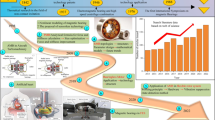Abstract
Magneto-rheological (MR) valve is one of the devices generally used to control the speed of Hydraulic actuator of MR fluid. The performance of valve depends on the magnetic circuit design. Present study deals with a new design of MR valve. A mathematical model for the MR valve is developed and the simulation is carried out to evaluate the newly developed MR valve. The design of the magnetic circuit is accomplished by magnetic finite element software such as Finite Element Method Magnetic (FEMMR). The model dimensions of MR valve, material properties are taken into account. The results of analysis are presented in terms of magnetic strength H and magnetic flux density B. The simulation results based on the proposed model indicate that the efficiency of the proposed MR valve is superior to two other types of MR valves, under the same magnetic flux density. As a conclusion, the new valve design has improved the efficiency of MR valve significantly.
Similar content being viewed by others
References
Bossis G, Lacis S, Meunier A, Volkova O (2002) Magnetorheological fluids. J Magn Magn Mater 252:224–228
Zipser L, Richter L, Lange U (2001) Magnetorhologic fluids for actuators. Sensors and Actuators A 92:318–325
Olabi AG, Grunwald A (2007) Design and application of magneto-rheological fluid. Mater Des 28:2658–2664
Laun HM, Gabriel C, Schmidt G (2008) Primary and secondary normal stress differences of a magnetorheological fluid (MRF) up to magnetic flux densities of 1 T J. Non-Newtonian Fluid Mech 148:47–56
Brigadnov IA, Dorfmann A (2005) Mathematical modeling of magnetorheological fluids. Continuum Mech Thermodyn 17:29–42
Kim Y, Langari R, Hurlebaus S (2009) Semiactive nonlinear control of a building with a magnetorheological damper system. Mech Syst Sig Process 23:300–315
Chen C-W (2009) Modeling and control for nonlinear structural systems via a NN-based approach. Expert Syst Appl 36:4765. doi:10.1016/j.eswa.2008.06.062
Yu M, Choi SB, Dong XM, Liao CR (2009) Fuzzy neural network control for vehicle stability utilizing magnetorheological suspension system. J Intell Mater Syst Struct 20:457, originally published online Sep 18
Chen C-Y, Lin J-W, Lee W-I, Chen C-W (2010) Fuzzy control for an oceanic structure: a case study in time-delay TLP system. J Vib Control 16:147. doi:10.1177/1077546309339424
Liang S-F, Shih-Mao L, Jyh-Yeong C (2008) A novel two-stage impulse noise removal technique based on neural networks and fuzzy decision. IEEE Trans Fuzzy Syst 16:863
Yokota S, Yoshida K, Kondoh Y (1999) A pressure control valve using MR fluid. Proc Forth JHPS-ISFP Tokyo 99:377–380
Songjing L, Guanghuai W, Dong Chen, Songying L (2002) New type relief valve using magneto-rheological fluid. Report of Harbin Institute of Technology Harbin, China
Yoo JH, Wereley NM (2002) Design of a high-efficiency magnetorheological valve. J Intell Mater Syst Struct 13:679
Li WH, Du H, Guo NQ (2003) Finite element analysis and simulation evaluation of a magnetorheological valve the international. J Adv Manufacture Technol 21:438–445
Ai HX, Wang DH, Liao WH (2006) Design and modeling of a magnetorheological valve with both annular and radial flow paths. J Intell Mater Syst Struct 17:327
Quoc-Hung N, Seung-Bok C, Wereley NM (2008) Optimal design of magnetorheological valves via a finite element method considering control energy and a time constant. Smart Mater Struct 17:025024, 12 pp
Quoc-Hung N, Young-Min H, Seung-Bok C, Wereley NM (2007) Geometry optimization of MR valves constrained in a specific volume using the finite element method. Smart Mater Struct 16:2242–2252
Jolly, MR, Carlson JD (1996) Controllable squeeze film damping using magnetorheological fluid Actuator 96, 5th Int. Conf. on New Actuators. In: H. Borgmann and K. Lenz (eds.) Axon Technologies Consult GmbH
Park EJ, da Luz LF, Suleman A (2008) Multidisciplinary design optimization of an automotive magnetorheological brake design. Comput Struct 86:207–216
Kelso, SP (2001) Experimental characterization of commercially practical magnetorheological fluid damper technology. Proceedings of SPIE Conference on Smart Structures and Materials, Paper No. 4332-34
Shaju J, Anirban C, Wereley NM (2008) A magnetorheological actuation system: test and model. Smart Mater Struct 17:025023, 15 pp
Yoo J-H, Wereley NM (2005) A magnetorheological piezohydraulic actuator. J Intell Mater Syst Struct 16:945
Author information
Authors and Affiliations
Corresponding author
Rights and permissions
About this article
Cite this article
Salloom, M.Y., Samad, Z. Finite element modeling and simulation of proposed design magneto-rheological valve. Int J Adv Manuf Technol 54, 421–429 (2011). https://doi.org/10.1007/s00170-010-2963-1
Received:
Accepted:
Published:
Issue Date:
DOI: https://doi.org/10.1007/s00170-010-2963-1




